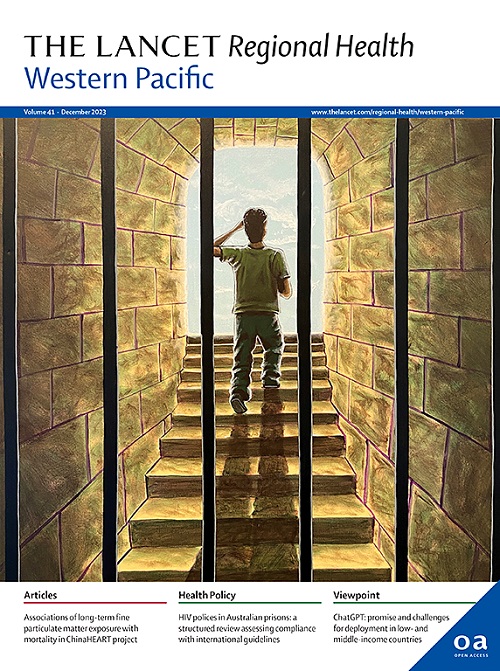Myopia and high myopia trends in Chinese children and adolescents over 25 years: a nationwide study with projections to 2050
IF 8.1
1区 医学
Q1 HEALTH CARE SCIENCES & SERVICES
引用次数: 0
Abstract
Background
The global rise in myopia, particularly in Asia, presents significant public health challenges. Analyzing trends and forecasting impacts are critical for developing strategies to mitigate this burden.
Methods
We conducted the largest study to date on myopia and high myopia prevalence in Chinese children and adolescents aged 7–18 years, analyzing data from 5,095,256 individuals across 119 studies from 1998 to 2022. Data variability between cycloplegia and non-cycloplegia measurements was addressed using a distance-based model averaging calibration. Aggregated prevalence and age-specific urban-rural trends were estimated using thin plate spline regression, with projections to 2050 derived from time series modeling.
Findings
Myopia prevalence plateaued in 2006 in urban areas and in 2013 in rural areas, with the urban-rural prevalence gap narrowing since 2015 (urban/rural ratio below 1.3 for all ages). By 2050, myopia prevalence is projected to stabilize at 27.1% (95% CI: 10.0–44.4%) for ages 7–9 and 81.5% (74.7–88.3%) for ages 16–18 in urban areas, and at 20.1% (8.6–31.7%) and 74.1% (63.2–84.8%), respectively, in rural areas. High myopia prevalence among adolescents aged 16–18 is expected to rise from 7.3% in 2001 to 22.1% by 2050. Prevalence correlated significantly with the Human Development Index (P < 0.001).
Interpretation
Despite stabilization in overall myopia prevalence, the continued rise in high myopia underscores the need for targeted control measures. Projections emphasize the importance of addressing regional disparities and prioritizing public health interventions.
Funding
National Natural Science Foundation of China (#82271086; #82388101; #72495123).
中国25岁以上儿童和青少年近视和高度近视趋势:一项预测到2050年的全国性研究
全球近视的增加,特别是在亚洲,给公共卫生带来了重大挑战。分析趋势和预测影响对于制定减轻这一负担的战略至关重要。方法:我们对中国7-18岁儿童和青少年的近视和高度近视患病率进行了迄今为止最大规模的研究,分析了1998年至2022年119项研究中5,095,256人的数据。使用基于距离的模型平均校准来解决单眼截瘫和非单眼截瘫测量之间的数据变异性。利用薄板样条回归估计了总患病率和特定年龄的城乡趋势,并根据时间序列模型预测了到2050年的趋势。研究发现,2006年城市地区和2013年农村地区的近视患病率趋于稳定,城乡患病率差距从2015年开始缩小(所有年龄段的城乡比低于1.3)。预计到2050年,城市地区7-9岁和16-18岁的近视患病率分别稳定在27.1% (95% CI: 10.0-44.4%)和81.5%(74.7-88.3%),农村地区分别稳定在20.1%(8.6-31.7%)和74.1%(63.2-84.8%)。16-18岁青少年的高度近视患病率预计将从2001年的7.3%上升到2050年的22.1%。患病率与人类发展指数(P <;0.001)。尽管总体近视患病率趋于稳定,但高度近视的持续上升强调了有针对性的控制措施的必要性。预测强调了解决区域差异和优先考虑公共卫生干预措施的重要性。国家自然科学基金(82271086;# 82388101;# 72495123)。
本文章由计算机程序翻译,如有差异,请以英文原文为准。
求助全文
约1分钟内获得全文
求助全文
来源期刊

The Lancet Regional Health: Western Pacific
Medicine-Pediatrics, Perinatology and Child Health
CiteScore
8.80
自引率
2.80%
发文量
305
审稿时长
11 weeks
期刊介绍:
The Lancet Regional Health – Western Pacific, a gold open access journal, is an integral part of The Lancet's global initiative advocating for healthcare quality and access worldwide. It aims to advance clinical practice and health policy in the Western Pacific region, contributing to enhanced health outcomes. The journal publishes high-quality original research shedding light on clinical practice and health policy in the region. It also includes reviews, commentaries, and opinion pieces covering diverse regional health topics, such as infectious diseases, non-communicable diseases, child and adolescent health, maternal and reproductive health, aging health, mental health, the health workforce and systems, and health policy.
 求助内容:
求助内容: 应助结果提醒方式:
应助结果提醒方式:


